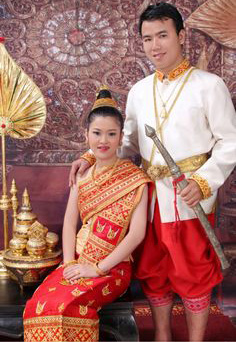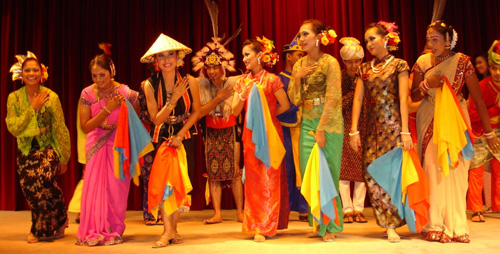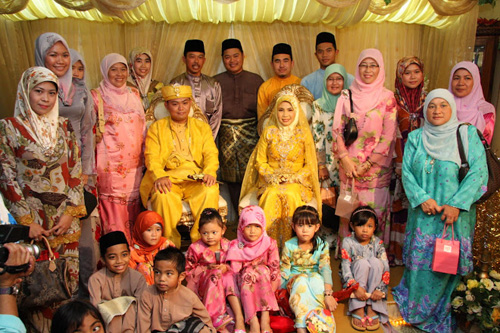 Asian countries have a lot in common, especially in traditional clothing. Of course, their cultures vary pretty much, but national costumes are often very similar. We'd like to tell you about five interesting Asian countries and their traditions in clothing. Cambodia, Laos, Malaysia, Philippines, and Brunei. Can you name their national attire? After reading this article, you will.
Asian countries have a lot in common, especially in traditional clothing. Of course, their cultures vary pretty much, but national costumes are often very similar. We'd like to tell you about five interesting Asian countries and their traditions in clothing. Cambodia, Laos, Malaysia, Philippines, and Brunei. Can you name their national attire? After reading this article, you will.
Cambodia
The national men's attire consists of a cotton or silk shirt with short sleeves, cotton trousers, a sampot, and a Khmer scarf. Everyday attire is simple, cotton and convenient. Festive one is bright, richly decorated and often made of silk.
Sampot is a long piece of cloth (1.5 m), both ends are sewn together. It looks like a kind of skirt, but actually, it is more like trousers. There are plenty variations of sampot. For example, Sampot Chang Kben (3m-long piece of cloth that is wrapped around the waist and tied up in a knot; the knot is pulled between the legs and held by a metal belt). Also there is a Sampot Phamuong – a single colored (52 different colors are used) sampot. Sampot Hol is another variation of this garment. It is a wrapping skirt which was formed under the influence of Indian clothing-style. Sampot Samloy is a long everyday skirt for men and women. Sampot Sang – short skirt with silk embroidery. And so on.

Cambodian festive attire. Photo from Wikipedia
Women traditionally wear a sampot, a blouse, and a Khmer scarf. There are several types of a traditional blouse in Cambodia. Av Dai Puon is a short-sleeved blouse with a row of buttons. Av Pnot Kback is a formal, beautifully decorated shirt for young ladies. Av Neang Nov is a long-sleeved shirt for women. Av Bar Bov is a sleeveless coat. And so on.
Another traditional piece of clothing in Cambodia is a Khmer scarf. It is woven from cotton or silk and serves to protect people from the hot sun. Khmer scarf is very popular and is considered to be a symbol of the Khmer kingdom.
Laos
Traditional costumes in Laos are various. There are specific features for different regions, communities, ethnic groups, and even families. Traditionally clothing used to be made of hemp, but today other materials are usually used (including cotton and silk). Lao national attire is very bright. It may consist of a long skirt with a richly embroidered foot called a sinh, a matching pha biang (shawl), and a blouse (called "suea pat"). The skirt consists of 3 parts: the main part, the waistband, and the hem. The shirt is long-sleeved and has no buttons. Pha biang can be worn by both men and women. It is a long and narrow piece of silk cloth that is draped diagonally around the chest covering one shoulder, its end drops behind the back.

A couple in Lao traditional clothes. Photo from Pinterest.com
Lao women often decorate their clothes with jewelry: pearls, silver coins, beadwork, silver embroidery etc. Traditionally women in Laos wear high hair-do, decorated with flowers, pearls, ribbons and jewelry.
Men in Laos wear Salong – large trousers. Also they use shirts, knee-long white socks, and a pha biang. Festive men's clothing is very colorful and decorated with coins, beadwork and embroidery.
Malaysia
The national men's costume in Malaysia is a Baju melayu. It consists of a loose tunic and trousers. Also men wear a Sampin (sarong) – a piece of cloth wrapped around hips. Men's Malay headdress is a Songkok, a cap, or a religious hat. Usually all the clothing in Malaysia is made of cotton or other natural materials. It is so because of heat, which is constant in Asia. Malay people like bright colors for national everyday and festive clothes. Not only women wear bright and colorful costumes, but men also do.

Different Malaysian costumes. Photo from Wikidot.com
Malay national women's attire is a Baju kurung. It consists of a knee-long blouse and a long skirt. A scarf or a shawl is also always worn. As Malaysia is an Islamic country, women cover all their body except face and hands. That's why they use Kemban – special sarong that covers head, shoulders and chest.
Philippines
The territories of the Philippines used to be colonies of Spain and US for a long time. This influenced the national Philippino attire pretty much. Today a lot of local people don't use traditional costumes, but at some areas (e.g. Tagalog, Bicolano, Visayan, Moro ethnic groups) Philippinos still retain their traditions and culture, including the national dress.
The traditional clothing of Philippines is a Barong Tagalog. Both men and women wear it. Barong Tagalog is a very thin and light embroidered garment, which is great for local climate. This attire is used as formal and wedding dress. Such clothing is often woven from banana fiber.

Traditional clothing of the Philippines: Barong Tagalog and Barot at saya. Photo from Pinterest.com
The favorite dress of Philippino women is a Barot at saya. Barot is a short sleeved blouse and saya is a long wrap around skirt. These clothes are very beautiful, richly embroidered and decorated with patterns on fabric.
Another form of dress that is popular in the Philippines is a Terno. It is a long formal dress with butterfly sleeves. Terno is also very beautiful, ornated, and feminine.
Brunei
Brunei national dress is similar to the Malaysian one, but more colorful. Men wear Baju Cara Melayu, women – Baju Kurong.
The rules for clothing in Brunei are very strict. As Brunei is an Islamic country, local women must wear clothes that cover all their body, except face and hands. That's why they use traditional head cover called "tudong". It's a scarf that covers hear. Women's everyday dress (Baju Kurong) has bright patterns and usually is made of cotton. Festive traditional attire is made of cotton or silk, decorated with embroidery and lace, but still rather modest.

Traditional wedding in Brunei. Photo from Weddingculturebrunei.blogspot.com
Men usually wear a shirt (knee-long and with long sleeves), trousers and a sarong. The sarong is a piece of cloth used as a covering. People in Brunei like this clothing very much. Not only men wear it, but women and children also do. Men either use sarong instead of trousers, or on top of them. In the 1st case sarong should be ankle-long, in the 2nd case half-way down to the knee. Men also wear traditional hats called "songkok". This cap is popular among Muslim males in Southeast Asian countries.


